Mongolia Notebooks
Notes from a second year in Ulaanbaatar, Mongolia's capital and largest city. Articles revolve, admittedly, in a wide orbit around the collision of cultures taking place as a rural nomadic population becomes increasingly urban, technological, and western. The title and first picture in each article link to more images and the rest of each story.
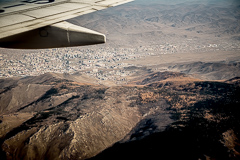
American Immigrant ~ 2015-10-18
When I left Mongolia in the middle of July I thought my effort to ward off the legal difficulties of my previous two trips had paid off and that the visa for my return had been arranged. It was, I thought, just a formality to mail my passport to the Mongolian Embassy in Washington DC and, because I was planning to be there in mid-August, walk in and pick it up. I had a letter of recommendation from the US embassy in Ulaanbaatar explaining my situation, recounting a personal conversation about some of the other difficulties that I've had in the past, the most problematic of which was a failure of Mongolian immigration officials to stamp my passport on leaving the country by train. By phone I also had an oral account of the discussion of my case with Mongolian immigration and the, also oral, account of the approval that was sure to be given to my application. more...
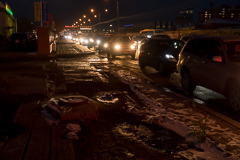
Where The Blind Lead the Blind ~ 2015-10-27
"Good morning," I announced to the six people whose heads turned my way as I walked into the Daisy Reading Room in back of the Ulaanbaatar Public Library. "It is Woody," I added, though I knew most of them by name, and I am sure they recognized my voice. It's hard to know how much to take for granted. Though my instinct with this group is to be overly cautious, they certainly don't need my help. They welcome me to their table even though they realize that for most of my career as a photographer I have pursued something that is absolutely useless to them. As always, I brace myself to learn something I never knew I didn't know. more...
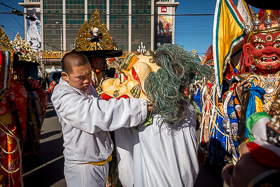
Ulaanbaatar's Surprise Party ~ 2015-10-31
By now I am used to having things happen around me unexpectedly. Not knowing Mongolian prevents overhearing news on the television or radio. The English language UB Post is sometimes helpful for things that are now recent history, not so much good for seeing what might happen tomorrow. On most days not knowing what will happen next is an appealing aspect of living in Mongolia, even though there are also times when it can be exhausting. For two years I have been like a young puppy in a new room, exploring everything and wondering how that got here, or how this works. I have also, unlike a puppy, worked under the assumption that the reason I don't know what is happening is that I am a foreigner, and those who are natives have an easier time of things. more...
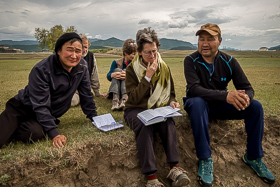
Finding The Nature ~ 2015-11-02
There is no part of speech in the Mongolian language that corresponds to our article, so it is common, even for Mongolians with good English skills, to drop a-s or the-s when speaking in English. What's not so common is to add these words in places where they are not usually used or needed. One common case of this additional use has become a small mystery to me. The word nature quite often comes bundled with the definite article the—as in the nature. While we do use that combination, it is always for another meaning of nature. The nature of a scientist is to be skeptical. The nature of a linguist is to use language precisely. That is just the nature of things. Here, when someone talks about the nature, they may not be talking about a characteristic of something. more...
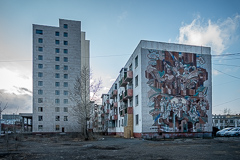
Public Land, Private Interest ~ 2015-12-01
Just south of Peace Bridge, where Chingis Avenue bends to head toward the airport, there's a building with its lower windows broken out, the entry boarded up after being vandalized. We have passed it many times in this same condition over the past two and a half years, though it still looks much newer than a lower row of apartments that runs immediately behind it. Here in Ulaanbaatar, many new buildings have been started without being finished, progress stalled by the problems haunting the economy. There are also many old buildings that have been abandoned, well along in the process of decay. This building is different. It looks like a new building that was finished, then abandoned before it was occupied. more...
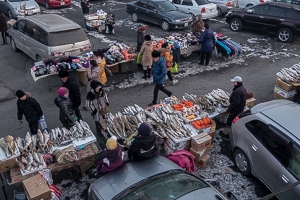
Mechanics of Winter ~ 2016-01-21
The caption on the lead photograph in the New York Times today was, "Choices were limited in the bread aisle of a grocery store on Thursday in Alexandria, Va." The photograph shows shelves that are practically bare, a man searching through the last few options after anxious shoppers stocked up for a predicted snowstorm. Here are a few notes on what some claim to be the coldest capital city in the world, where fish can be sold outside without refrigeration for nearly six months of the year. more...
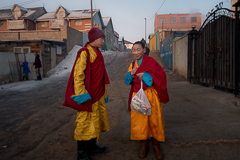
White Moon, White Month ~ 2016-02-18
Mongolia is among the Asian countries that celebrate the new year using a lunar calendar instead of a solar one—or one devised by ancient Romans—meaning, from a solar or Roman perspective, that its Tsagaan Sar (white + either moon or month) occurs at a different time every year. If you were a herder in Mongolia any time in the past thousand years or so, White Month, the month that begins when the new moon slips backwards behind the sun as the days start to get longer, would be your sign that marks the end of the coldest part of winter. It's a reason for celebration, occasion for giving thanks to the gracious spirit that kept your mal from starvation, and more importantly, the time to perform the rituals that will bring you luck in the coming year. more...
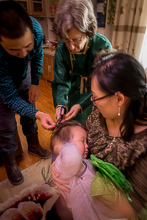
A First Haircutting Expedition ~ 2016-02-28
When we first came to Mongolia we were warned not to touch someone's head, even children, and even in a playful way, and to avoid touching another person's hat, even in admiration. I read that Mongolians do not bow their heads like other Asians, something they were once forced to do as they were beheaded by the Chinese. I have heard, from a very urban and contemporary Mongolian, that her rural relatives have been reluctant to move from the countryside to an apartment, in part because of the thought of someone else's feet above their heads—as well as the whole idea of living beneath someone's bathroom. more...
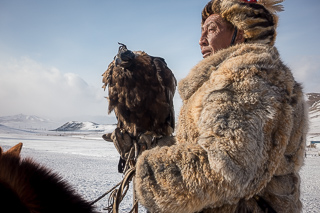
Eagle Festival ~ 2016-03-10
It's hard to know what the best way is to preserve practices that are peculiar to a dwindling culture. Before the days of global communication and easy travel—plane, train, or especially car and truck— people in the same community passed information from old to young, one generation to the next, and much of that information stayed there. Geographic obstacles limited the spread of a culture, but also protected it from outside influence. Eventually isolated areas developed language, customs, music, and other practices that were unique, either by chance or by challenges developed to cope with environmental conditions. more...
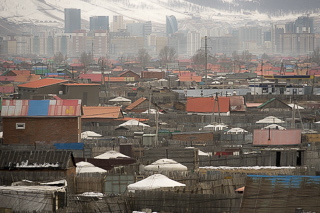
Ger Areas ~ 2016-03-20
Surrounding central Ulaanbaatar's steel and glass office buildings, the several generations of impregnable Soviet apartment buildings, and the new block-brick-and-stucco apartments are what are known here as ger districts or sometimes ger areas. On a city map they are drawn in the palest gray, just slightly darker than the paper-white irregular passageways marking the dirt connections between them, hinting that there is nothing of importance to see there. more...
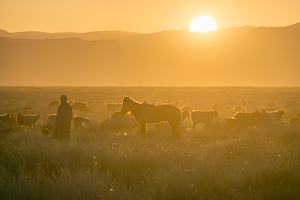
A Mongolian Dream ~ 2016-04-18
You are more Mongolian than Mongolians, my colleague Bayaraa from the State University of Arts and Culture joked when I told her that we—Judy, her son Andrew and his partner Bonnie visiting from the US, and I—were headed for Khovd and Bayan Ulgii for a week, and that on our agenda was an invitation to spend time with mal—goats, sheep, cows, a few horses, and many camels as well as malchin, their herders. She ignores, among other things, the fact that I speak only the barest rudiments of her language, but if you can stretch your imagination, there is still a little truth to what she is telling me. I am flattered, and yet a little embarrassed. more...
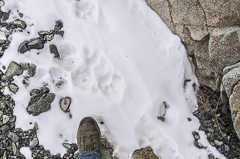
Ирвэс ~ 2016-04-19
Peter Matthiessen did not see one for the two months that he was looking in the Himalayas, but still named his most famous book after it. For two seasons a team of Japanese scientists traveled to Mongolia's Jargalant Uul to look for them. They were nearing the end of their third year without finding one when their luck changed. A Mongolian woman working as their cook decided to help, and along with her brother they climbed to a point where they had a view from above, a strategy usually used by the snow leopards they were looking for, to spot the ibex and argali sheep that they prey on. more...
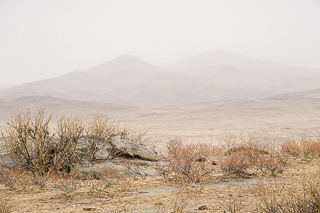
Western Travel ~ 2016-04-21
Over coffee with Dimitri Staszewski, a Fulbright Fellow who is collecting folk music from non-professional musicians among the nomadic herders in Mongolia, I asked about his recent trip to Bayan Ulgii, Mongolia's western-most aimag, and particularly, since we were planning a trip there, how he got from place to place and if he could recommend a driver and guide. more...
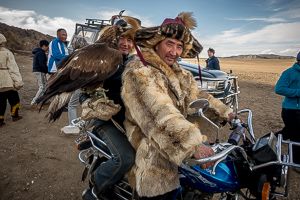
Eagle Hunters ~ 2016-04-23
Once practiced much more widely than it is now, there are, by our guide Nurbolat's estimate, fourteen Kazakh eagle hunting families left in western Mongolia. For centuries it's been a practice that was useful for catching animals that were used for their skins and sometimes for food. Hunting with eagles continues to provide food and clothing, but in a less direct way—it now brings in money that comes from satisfying tourists's fascination with this ancient tradition. more...
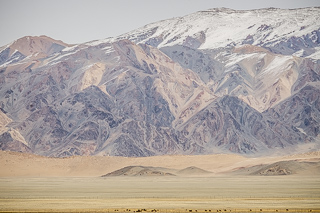
A Few More Notes from Bayan Ulgii ~ 2016-04-24
Before leaving Agalai's home we made a side trip to see petroglyphs near the small town of Altan Tsogts, and stopped for views of Tsambagarav, a snow-covered mass that includes Mongolia's fifth and sixth highest peaks (both around 13,600', 4165m) which was nearly but not completely free of clouds on our way back—though invisible the day before as we crawled around its base. We will spend the next two nights in Ulgii, the aimag capital of Bayan Ulgii, which is an hour from Agalai's home. After dropping him off at a relative's home for his dentist's appointment, we drove and then took stairs to an overlook of the city. more...
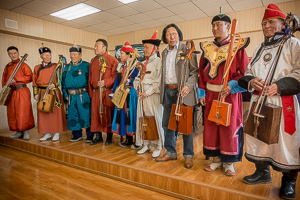
Players from across the country have gathered here in Ulaanbaatar today to share knowledge, technique, and unique melodies from their homelands. By luck, I had just found a new morin khuur teacher and had lined up this date for our first meeting. But yesterday, before that first meeting, Battugs sent an email saying that we would go to the International Morin Khuur Symposium instead of meeting in his office, that I would not need my instrument, but that if I had a camera, I should bring it. more...
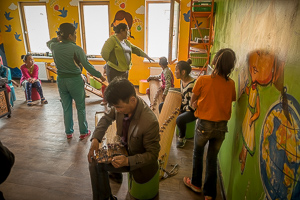
Mr. Fixit Meets Mongolia ~ 2016-06-01
For several months now I have been spending a day a week at Lotus Children's Center trying to repair a few of the many things that come undone there. I volunteered because I'd like to help with something I am good at, and to do something that is needed. (In addition to the many things that are broken, there are many, many other needs!) What seemed like an obvious matching of needs and skills has refreshed my appreciation for how easy it is to get things done in the United States. more...
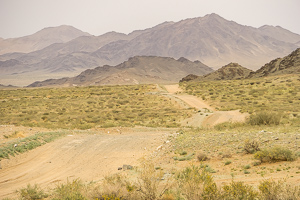
Finding Western Zavkhan ~ 2016-07-01
For all the traveling on the ground we have been lucky enough to do here, none of it has been without deadlines that prevented exploration and with a few exceptions, all but very quick photography. So in this last month here I made plans to travel at a different pace—a photographer's pace—to try to find the land I had seen from the air on our first flight across this sparse country. On that trip we crossed the largest piece of unmarked land I have ever seen. Much of it appeared to be desert or mountains, landscape I was familiar with in smaller doses, so I could imagine what it would look like from the ground. But there were other areas that left me stumped—striped patches of earth—red, tan, green, with veins running through what were obviously caused by water erosion, but which were still not quite understandable from five miles in the air. Over the next three years we would fly over this mystery land many times. more...
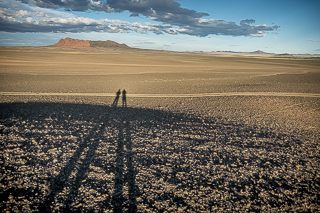
Mystery Land ~ 2016-07-10
Once we got a few kilometers west of Uliastai, turning north at a memorial for what seemed to be some very special race horses, the pavement stopped and the land opened up in a way that is rare even in Mongolia—not only are there few people, there are few grazing animals as well. At first we traveled up a wide green valley knee-deep in lush grass. A couple of ridges later where we stopped for the night the grass was ankle deep, and an hour into the next morning the lush landscape of the previous day had diminished to thin patches of green haze clinging to the sand. In the rest of Mongolia the horizon would be scattered with occasional white gers, but not here. When we did see animals here they were sad, recently molted camels, who do belong to someone even though we couldn't imagine where their owners might be. more...